

Publication: The Structure and Characteristics of #PhDChat. One of the highlights of academia is working closely with students and seeing them grow, take on challenges, struggle, and create meaningful change in the world.

This happens in classrooms, on the web, in design/development projects, in research endeavors, and so on. Kasey Ford, who was one of my advisees, recently completed her MA thesis examining #PhDChat, an online social network, and we have published a study out of that work in the Journal of Interactive Media in Education. I’m excited to share the abstract below: #PhDChat is an online network of individuals that has its roots to a group of UK doctoral students who began using Twitter in 2010 to hold discussions. Since then, the network around #PhDchat has evolved and grown. Ford, K., Veletsianos, G., & Resta, P. (2014). Visualizing my understanding of connectivism. I have often tried to explain my biggest problem with connectivism (most recently on Friday).
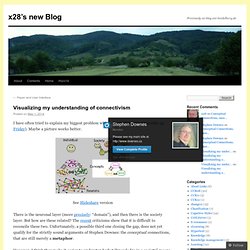
Maybe a picture works better. See Slideshare version There is the neuronal layer (more precisely: “domain”), and then there is the society layer. But how are these related? The recent criticisms show that it is difficult to reconcile these two. However, I think they make it easier to understand what “knowledge in a society” means. Journal of Learning Analytics. More on Connectivism: a response to Stephen Downes. This is my (lengthy) response to Stephen Downes's responses to my previous post on connectivism .

For those catching up with this, my original post was an attempt to make sense of Downes's view of connectivism as a distinctive learning theory, in which I compared it with other related theories, then examined it on its own terms before concluding that connectivism was better seen as a theory for learning than a theory of learning. I saw this as a good thing because the more open formulation as a theory for learning allows us to treat it as a transformative set of related ideas, a fairly tight theme around which we can explore a range of adjacent possibles and move forward more effectively as a set of people with shared interests working in very closely related areas on how to better support learning in the networked age.
Things I will not respond to in detail. MOOCs’ disruption is only beginning. Educación Abierta: Apertura de la Educación, por Yves Punie. Vuelve Yves Punie ante la audiencia reunida hoy en el Parque Científico y Tecnológico de Gipuzkoa, para la jornada abierta del IKANOS Workshop 2014, en esta ocasión para hablar sobre Educación Abierta.

¿Que significa “abierto” para la gran mayoría de nosotros? Una búsqueda en Google nos devuelve como principales resultados términos relacionados con el software libre, con los que la Educación Abierta comparte, o debería compartir, valores, procesos y resultados. Punie nos habla de una tendencia hacia la apertura, algo que realmente no es nuevo, no empezó de hecho con la iniciativa de OER de la UNESCO en 2002, citada en muchas ocasiones como tal. Se viene hablando desde hace varias décadas de lo abierto en educación pero claramente se ha acelerado esta tendencia hacia la apertura, como el resto de cuestiones tocadas por las tecnologías, durante esta última década. Sacar la clase del Aula. Profesorado, Vol. 18, 1 (2014): Los MOOC y la Educación Superior: La Expansión del Conocimiento. You can now download the open data of the European MOOCs Scoreboard. Hoy traemos a este espacio del portal Open Education Europa, una recopilación de datos europeos sobre MOOC ...
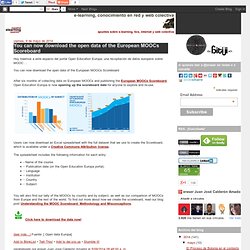
You can now download the open data of the European MOOCs Scoreboard After six months of collecting data on European MOOCs and publishing the European MOOCs Scoreboard, Open Education Europa is now opening up the scoreboard data for anyone to explore and re-use. Users can now download an Excel spreadsheet with the full dataset that we use to create the Scoreboard, which is available under a Creative Commons Attribution license. The spreadsheet includes the following information for each entry: - Name of the course- Publication date (on the Open Education Europa portal)- Language- Institution- Country- Subject You will also find our tally of the MOOCs by country and by subject, as well as our comparison of MOOCs from Europe and the rest of the world.
Click here to download the data now! Why Design a xMOOC / cMOOC Hybrid? LTCA Theory. So a lot of interest in the earlier post about creating a dual-layer cMOOC/xMOOC, as well as some of the inevitable backlash.
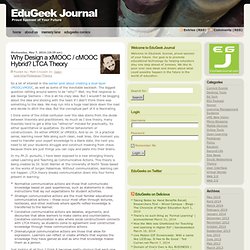
The biggest question rattling around seems to be “why?” Well, my first response is: ask George Siemens – this is all his crazy idea. But I wouldn’t be blogging about the idea and sticking with the team if I didn’t think there was something to the idea. We may run into a huge road block down the road and decide to ditch the idea. EL DOLOR Y LA RABIA. May092014 English translationTraductions en françaisTraduzione italianoDeutsch ÜbersetzungΕλληνική μετάφραση.
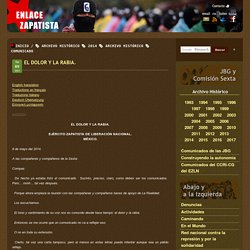
“Felicidades a 131 Alumnos de la Ibero yo soy el 132″ el tweet que dio origen a una revolución. Mireles en la mira. La verdadera guerra de Peña Nieto. Víctor M.
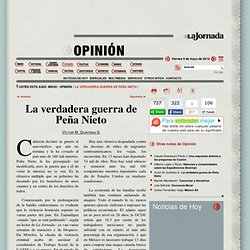
Quintana S. alderón declaró su guerra al narcotráfico, que aún no termina y le ha costado al país más de 100 mil muertos.